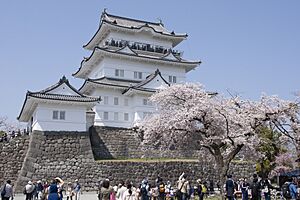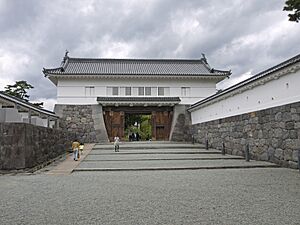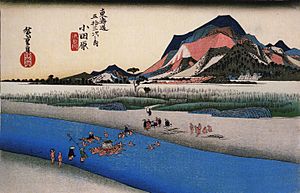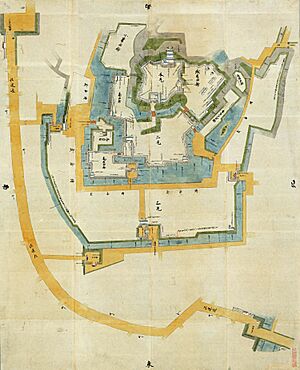Odawara Castle facts for kids
Quick facts for kids Odawara Castle小田原城 |
|
|---|---|
| Odawara, Kanagawa Prefecture, Japan | |
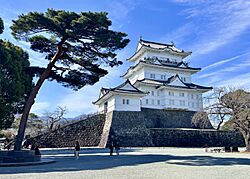
Reconstructed keep of Odawara castle
|
|
| Lua error in Module:Location_map at line 420: attempt to index field 'wikibase' (a nil value). | |
| Type | Hirayama-style Japanese castle |
| Site information | |
| Open to the public |
yes |
| Site history | |
| Built | 1447, rebuilt 1633, 1706 |
| In use | Kamakura period-1889 |
| Battles/wars | Siege of Odawara (1561) Siege of Odawara (1569) Siege of Odawara (1590) |
Odawara Castle (小田原城, Odawara-jō) is a famous Japanese castle located in the city of Odawara in Kanagawa Prefecture, Japan. It's a "hirayama-style" castle, meaning it's built on a hill surrounded by plains.
The main tower, called a donjon (or keep), that you see today was rebuilt in 1960 using strong concrete. It stands on the original stone base of an older tower that was taken down between 1870 and 1872. People have built forts and castles in this area since the Kamakura Period (which was from 1185 to 1333).
Odawara Castle is recognized as one of the 100 Fine Castles of Japan. This special list was created by the Japan Castle Foundation in 2006.
Contents
A Look Back: Odawara Castle's History
Odawara was an important place for the Doi family during the Kamakura period. Later, a fortified house was built here by the Kobayakawa family. In 1495, a powerful leader named Ise Moritoki, who started the Later Hōjō clan, took control of Odawara.
How the Hōjō Clan Built Up the Castle
Over five generations, the Odawara Hōjō clan made Odawara Castle bigger and stronger. It became the main center of their lands, which covered most of the Kantō region of Japan.
During the Sengoku period (a time of many wars in Japan), Odawara Castle was known for its amazing defenses. It was built on a hill and had deep moats (ditches) filled with water on one side and dry ditches on the other. There were also high banks, strong walls, and steep cliffs all around. These defenses helped the castle survive attacks from famous warlords like Uesugi Kenshin in 1561 and Takeda Shingen in 1569.
In 1587, the Hōjō clan made the castle even stronger because they knew a big fight with Toyotomi Hideyoshi was coming. However, during the Battle of Odawara in 1590, Hideyoshi managed to make the Hōjō clan surrender without even attacking the castle directly! He surrounded it for three months and used clever tricks. After the surrender, Hideyoshi ordered most of the castle's defenses to be destroyed. He then gave the land to his top general, Tokugawa Ieyasu.
Odawara Castle in the Edo Period
After Ieyasu finished building Edo Castle, he gave Odawara Castle to one of his trusted helpers, Ōkubo Tadayo. Tadayo rebuilt the castle, but it was much smaller than the Hōjō clan's huge fortress. The new castle fit inside what used to be just one part of the old castle.
The castle was damaged several times by big earthquakes, including one in 1703 that destroyed most of its buildings. The main tower was rebuilt by 1706, but it took until 1721 to fix the rest of the castle. More damage happened in 1782 and 1853 from other earthquakes.
During the Boshin War (a civil war in Japan) in the 1860s, the leader of Odawara, Ōkubo Tadanori, allowed the Imperial forces to pass through without a fight. This helped the new Meiji government take power.
Odawara Castle in Modern Times
After the Meiji government took over, they ordered many old feudal castles to be torn down. So, all the buildings of Odawara Castle were removed between 1870 and 1872.
In 1893, a Shinto shrine was built on the stone base where the old main tower used to stand. Later, in 1901, an Imperial Villa (a special house for the Emperor) was built on the castle grounds. However, this villa was destroyed by the massive 1923 Great Kantō earthquake, which also caused many of the castle's stone walls to fall apart.
Restoring the Castle for Everyone
Repairs were made to the stone walls in the 1930s. In 1938, the castle site was declared a National Historic Site, meaning it was protected for its historical importance.
In 1950, more repairs were done to the stone base of the main tower. The area was then turned into the Odawara Castle Park, which includes a museum, a library, and even a small zoo.
The three-tiered, five-story main tower was rebuilt in 1960. It was made of reinforced concrete to celebrate Odawara becoming a city 20 years earlier. However, this rebuilt tower isn't exactly like the original because an observation deck was added at the top for visitors to enjoy the view.
Since the 1960s, there have been plans to restore the castle grounds more accurately to how they looked in the late Edo period. Because of these plans, several important gates have been rebuilt:
- The Tokiwagi Gate (常磐木門) in 1971.
- The Akagane Gate (銅門) in 1997.
- The Umadashi Gate (馬出門) in 2009.
The castle tower itself was updated between July 2015 and April 2016 to make it more resistant to earthquakes and to improve its exhibits. When it reopened, the entry fees collected on that day were donated to help repair Kumamoto Castle, which had been damaged by earthquakes in 2016.
Odawara Castle continues to be a popular place for visitors to learn about Japanese history and enjoy its beautiful grounds.
Images for kids
See also
 In Spanish: Castillo Odawara para niños
In Spanish: Castillo Odawara para niños


